Senegal
Republic of Senegal République du Sénégal (French) | |
|---|---|
| Motto: "Un Peuple, Un But, Une Foi" (French) "One People, One Goal, One Faith" | |
| Anthem: Pincez Tous vos Koras, Frappez les Balafons Everyone strum your koras, strike the balafons | |
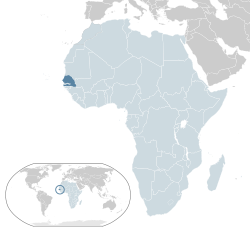 Location of Senegal (dark blue) – in Africa (light blue & dark grey) | |
 | |
| Capital and largest city | Dakar |
| Official languages | French |
| Recognised regional languages | |
| Ethnic groups ([2]) | |
| Demonym(s) | Senegalese |
| Government | Semi-presidential republic |
| Macky Sall | |
| Mohammed Dionne | |
| Legislature | Parliament |
| Senate (disbanded) | |
| National Assembly | |
| Independence | |
• from Francea | 4 April 1960 |
• Withdrawal from the Mali Federation | 20 August 1960 |
| Area | |
• Total | 196,712 km2 (75,951 sq mi) (87th) |
• Water (%) | 2.1 |
| Population | |
• 2013 estimate | 13,567,338 (67th) |
• 2013 census | 13,508,715 |
• Density | 68.7/km2 (177.9/sq mi) (134th) |
| GDP (PPP) | 2016 estimate |
• Total | $38.912 billion[3] |
• Per capita | $2,525[3] |
| GDP (nominal) | 2016 estimate |
• Total | $15.197 billion[3] |
• Per capita | $986[3] |
| Gini (2011) | 40.3[4] medium inequality |
| HDI (2013) | low (163rd) |
| Currency | CFA franc (XOF) |
| Time zone | UTC |
| Drives on | right |
| Calling code | +221 |
| ISO 3166 code | SN |
| Internet TLD | .sn |
| |
Senegal (/ˌsɛn[invalid input: 'ɨ']ˈɡɔːl, -ˈɡɑːl/ ;[6][7] Template:Lang-fr), officially the Republic of Senegal (Template:Lang-fr [ʁepyblik dy seneɡal]), is a country in West Africa. Senegal is bordered by the North African country of Mauritania in the north, Mali to the east, Guinea to the southeast, and Guinea-Bissau to the south-southwest. Senegal also shares a maritime border with Cape Verde. Senegal's economical and political capital is Dakar. It is the westernmost country in the mainland of the Old World, or Eurafrasia,[8] and owes its name to the Senegal River, which borders it to the east and north. The name "Senegal" comes from the Wolof "Sunuu Gaal," which means "Our Boat." Senegal covers a land area of almost 197,000 square kilometres (76,000 sq mi) and has an estimated population of about 13 million. The climate is Sahelian, but there is a rainy season.
Cultures and influences
The territory of modern Senegal has been inhabited by various ethnic groups since the prehistoric era. Organized kingdoms emerged around the seventh century, and parts of the country were ruled by prominent regional empires such as the Wolof. The present state of Senegal has its roots in European colonialism, which began during the mid-15th century, when various European powers began competing for trade in the area. The establishment of coastal trading posts gradually gave way to control of the mainland, culminating in French rule of the area by the 19th century, albeit amid much local resistance. Senegal peacefully attained independence from France in 1960, and has since been among the more politically stable countries in Africa.
Senegal's economy is centered mostly on commodities and natural resources. Major industries are fish processing, phosphate mining, fertilizer production, petroleum refining, construction materials, ship construction and repair. Like most African nations, agriculture is a major sector, with Senegal producing several important cash crops, including peanuts, sugarcane, cotton, green beans, tomatoes, melons, and mangoes.[9] Owing to its relative stability, tourism and hospitality are also burgeoning sectors.
A multiethnic and secular nation, Senegal is predominantly Sunni Muslim with Sufi and animist influences. French is the official language, although many native languages are spoken and recognized. Since April 2012 Senegal's president has been Macky Sall. Senegal has been a member of the Organisation Internationale de la Francophonie since 1970.
Etymology
Senegal is named after the Senegal River, the etymology of which is contested. One popular theory (proposed by David Boilat in 1853) is that it stems from the Wolof phrase sunu gaal, which means "our canoe" (or pirogue), resulting from a miscommunication between 15th-century Portuguese sailors and Wolof fishermen. The "our canoe" theory has been popularly embraced in modern Senegal for its charm and its use in appeals to national solidarity (e.g. "we're all in the same canoe") are frequently heard in the media.[citation needed]
Modern historians believe the name probably refers to the Berber Zenaga people, who lived on the northern side of the river. A competing theory is that it derives from the medieval town of "Sanghana" (also spelled as Isenghan, Asengan, Singhanah), described by the Arab geographer al-Bakri in 1068 as located by the mouth of the river. Some Serer people from the south believe the river's name is derived from the compound of the Serer term Sene (from Roge Sene, Supreme Deity in Serer religion) and O Gal (meaning "body of water").
History
Early and pre-colonial eras
Archaeological findings throughout the area indicate that Senegal was inhabited in prehistoric times and has been continuously occupied by various ethnic groups. Some kingdoms were created around the 7th century: Takrur in the 9th century, Namandiru and the Jolof Empire during the 13th and 14th centuries. Eastern Senegal was once part of the Ghana Empire.
Islam was introduced through Toucouleur and Soninke contact with the hypo-Saharan Almoravid dynasty, who in turn propagated it. The Almoravids, with the help of Toucouleur allies, used military force for conversion. This movement faced resistance from ethnicities of traditional religions, the Serers in particular.[10][11]
In the 13th and 14th centuries, the area came under the influence of the empires to the east; the Jolof Empire of Senegal was also founded during this time. In the Senegambia region, between 1300 and 1900, close to one-third of the population was enslaved, typically as a result of captives taken in warfare.[12]
In the 14th century the Jolof Empire grew powerful, having united Cayor and the kingdoms of Baol, Sine, Saloum, Waalo, Futa Tooro and Bambouk. The empire was a voluntary confederacy of various states rather than an empire built on military conquest.[13][14] The empire was founded by Ndiadiane Ndiaye, a part Serer[15][16] and part Toucouleur, who was able to form a coalition with many ethnicities, but collapsed around 1549 with the defeat and killing of Lele Fouli Fak by Amari Ngone Sobel Fall.
Colonial era
In the mid-15th century, the Portuguese landed on the Senegal coastline, followed by traders representing other countries, including the French.[17] Various European powers—Portugal, the Netherlands, and Great Britain—competed for trade in the area from the 15th century onward. In 1677, France gained control of what had become a minor departure point in the Atlantic slave trade—the island of Gorée next to modern Dakar, used as a base to purchase slaves from the warring chiefdoms on the mainland.[18][19]
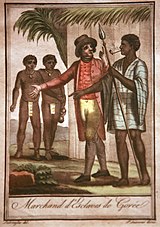
European missionaries introduced Christianity to Senegal and the Casamance in the 19th century. It was only in the 1850s that the French began to expand onto the Senegalese mainland – they had abolished slavery and promoted an abolitionist doctrine-,[20] adding native kingdoms like the Waalo, Cayor, Baol, and Jolof Empire. French colonists progressively invaded and took over all the kingdoms except Sine and Saloum under Governor Louis Faidherbe.[13][21] Senegalese resistance to the French expansion and curtailing of their lucrative slave trade was led in part by Lat-Dior, Damel of Cayor, and Maad a Sinig Kumba Ndoffene Famak Joof, the Maad a Sinig of Sine, resulting in the Battle of Logandème.
Independence (1960)
On 4 April 1959 Senegal and the French Sudan merged to form the Mali Federation, which became fully independent on 20 June 1960, as a result of the independence and the transfer of power agreement signed with France on 4 April 1960. Due to internal political difficulties, the Federation broke up on 20 August, when Senegal and French Sudan (renamed the Republic of Mali) each proclaimed independence.
Léopold Sédar Senghor was proclaimed Senegal's first president in September 1960. Senghor was a very well-read man, educated in France. He was a poet, a philosopher and personally drafted the Senegalese national anthem, "Pincez tous vos koras, frappez les balafons". Pro-African, he advocated a brand of African socialism.[22]

In 1980, President Senghor decided to retire from politics. The next year, he transferred power in 1981 to his hand-picked successor, Abdou Diouf. Former prime minister Mamadou Dia, who was Senghor's rival, ran for election in 1983 against Diouf but lost. Senghor moved to France, where he died at the age of 96.
Senegal joined with the Gambia to form the nominal Senegambia Confederation on 1 February 1982. However, the union was dissolved in 1989. Despite peace talks, a southern separatist group (Movement of Democratic Forces of Casamance or MFDC) in the Casamance region has clashed sporadically with government forces since 1982 in the Casamance conflict. In the early 21st century, violence has subsided and President Macky Sall held talks with rebels in Rome in December 2012.[23]
Abdou Diouf was president between 1981 and 2000. He encouraged broader political participation, reduced government involvement in the economy, and widened Senegal's diplomatic engagements, particularly with other developing nations. Domestic politics on occasion spilled over into street violence, border tensions, and a violent separatist movement in the southern region of the Casamance. Nevertheless, Senegal's commitment to democracy and human rights strengthened. Abdou Diouf served four terms as president.
In the presidential election of 1999, opposition leader Abdoulaye Wade defeated Diouf in an election deemed free and fair by international observers. Senegal experienced its second peaceful transition of power, and its first from one political party to another. On 30 December 2004 President Wade announced that he would sign a peace treaty with the separatist group in the Casamance region. This, however, has yet to be implemented. There was a round of talks in 2005, but the results have not yet yielded a resolution.
Politics

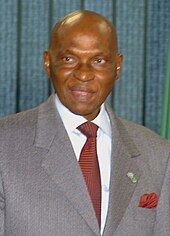
Senegal is a republic with a presidency; the president is elected every five years as of 2001, previously being seven years, by adult voters. The first president, Léopold Sédar Senghor, was a poet and writer, and was the first African elected to the Académie française. Senegal's second president, Abdou Diouf is the current general secretary of the Organisation de la Francophonie. The third president was Abdoulaye Wade, a lawyer. The current president is Macky Sall, elected in March 2012.
Senegal has more than 80 political parties. The unicameral parliament consists of the National Assembly, which has 150 seats (a Senate was in place from 1999 to 2001 and 2007 to 2012).[2] An independent judiciary also exists in Senegal. The nation's highest courts that deal with business issues are the constitutional council and the court of justice, members of which are named by the president.
Political culture
Currently, Senegal has a quasi-democratic political culture, one of the more successful post-colonial democratic transitions in Africa. Local administrators are appointed by, and responsible to, the president. The marabouts, religious leaders of the various Senegalese Muslim brotherhoods, also exercise a strong political influence in the country especially during Wade's presidency. In 2009, however, Freedom House downgraded Senegal's status from 'Free' to 'Partially Free', based on increased centralisation of power in the executive. However, it has since recovered its Free status by 2014.[24]
In 2008, Senegal finished in 12th position on the Ibrahim Index of African Governance.[25] The Ibrahim Index is a comprehensive measure of African governance (limited to sub-Saharan Africa until 2008), based on a number of different variables which reflect the success with which governments deliver essential political goods to their citizens. When the Northern African countries were added to the index in 2009, Senegal's 2008 position was retroactively downgraded to 15th place (with Tunisia, Egypt and Morocco placing themselves ahead of Senegal). As of 2012[update], Senegal's rank in the Ibrahim Index has decreased another point to 16 out of 52 African countries.
On 22 February 2011, it was reported that Senegal has severed diplomatic ties with Iran, saying Tehran supplied rebels with weapons which killed Senegalese troops in the Casamance conflict.[citation needed]
On 26 February 2012, Senegal held presidential elections which were perceived as controversial due to President Wade's candidacy. The controversy stemmed from the fact that although the Senegalese constitution did not allow a president to serve more than two terms, President Wade amended the constitution last year which allowed him to run for a third term. Several youth opposition movements, including M23 and Y'en a Marre, emerged in June 2011 to contest the amendment. In the end, Macky Sall of the Alliance for the Republic won, and Wade conceded the election to Sall. This peaceful and democratic transition was hailed by many foreign observers, such as the EU[26] as a show of "maturity".
On 19 September 2012, lawmakers voted to do away with the senate to save an estimated $15 million.[27]
Administrative divisions

Senegal is subdivided into 14 regions,[28] each administered by a Conseil Régional (Regional Council) elected by population weight at the Arrondissement level. The country is further subdivided by 45 Départements, 103 Arrondissements (neither of which have administrative function) and by Collectivités Locales, which elect administrative officers.[29]
Regional capitals have the same name as their respective regions:
Foreign relations
Senegal has a high profile in many international organizations and was a member of the UN Security Council in 1988-89. It was elected to the UN Commission on Human Rights in 1997. Friendly to the West, especially to France and to the United States, Senegal also is a vigorous proponent of more assistance from developed countries to the Third World.
Senegal enjoys mostly cordial relations with its neighbors. In spite of clear progress on other fronts with Mauritania (border security, resource management, economic integration, etc.), there remains the problem of an estimated 30,000 Afro-Mauritanian refugees living in Senegal.
Senegal is part of the Economic Community of West African States (ECOWAS). Integrated with the main bodies of the international community, Senegal is also a member of the African Union (AU) and the Community of Sahel-Saharan States.
Military

The Senegalese armed forces consist of about 19,000 well-trained and disciplined personnel in the army, air force, navy, and gendarmerie. The Senegalese military force receives most of its training, equipment, and support from France and the United States. Germany also provides support but on a smaller scale.
Military noninterference in political affairs has contributed to Senegal's stability since independence. Senegal has participated in many international and regional peacekeeping missions. Most recently, in 2000, Senegal sent a battalion to the Democratic Republic of Congo to participate in MONUC, the United Nations peacekeeping mission, and agreed to deploy a United States-trained battalion to Sierra Leone to participate in UNAMSIL, another UN peacekeeping mission.
In 2015, Senegal participated in the Saudi Arabian-led military intervention in Yemen against the Shia Houthis.[30]
Law
Senegal is a secular state, as defined in its Constitution.[31]
To fight corruption, the government has created the National Anti-Corruption Office (OFNAC) and the Commission of restitution and recovery of illegally acquired assets. According to Business Anti-Corruption Portal, President Sall created the OFNAC to replace the Commission Nationale de Lutte Contre la non Transparence, la Corruption et la Concussion (CNLCC). It is said that the OFNAC represents a more effective tool for fighting corruption than the CNLCC established under former President Wade.[32] The mission of OFNAC is to fight corruption, embezzlement of public funds and fraud. OFNAC has the power of self-referral (own initiative investigation). OFNAC is composed of twelve members appointed by decree.
Geography
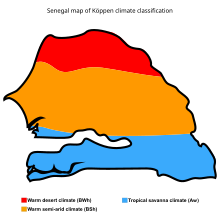
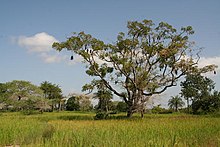
Senegal is located on the west of the African continent. It lies between latitudes 12° and 17°N, and longitudes 11° and 18°W.
Senegal is externally bounded by the Atlantic Ocean to the west, Mauritania to the north, Mali to the east, and Guinea and Guinea-Bissau to the south; internally it almost completely surrounds The Gambia, namely on the north, east and south, except for Gambia's short Atlantic coastline.
The Senegalese landscape consists mainly of the rolling sandy plains of the western Sahel which rise to foothills in the southeast. Here is also found Senegal's highest point, an otherwise unnamed feature near Nepen Diakha at 584 m (1,916 ft). The northern border is formed by the Senegal River, other rivers include the Gambia and Casamance Rivers. The capital Dakar lies on the Cap-Vert peninsula, the westernmost point of continental Africa.
The Cape Verde islands lie some 560 kilometres (350 mi) off the Senegalese coast, but Cap-Vert ("Cape Green") is a maritime placemark, set at the foot of "Les Mammelles", a 105-metre (344 ft) cliff resting at one end of the Cap-Vert peninsula onto which is settled Senegal's capital Dakar, and 1 kilometre (0.6 mi) south of the "Pointe des Almadies", the westernmost point in Africa.
Climate
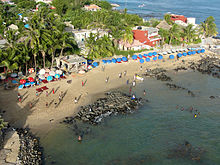
Senegal has a tropical climate with pleasant heat throughout the year with well-defined dry and humid seasons that result from northeast winter winds and southwest summer winds. The dry season (December to April) is dominated by hot, dry, harmattan wind.[2] Dakar's annual rainfall of about 600 mm (24 in) occurs between June and October when maximum temperatures average 30 °C (86.0 °F) and minimums 24.2 °C (75.6 °F); December to February maximum temperatures average 25.7 °C (78.3 °F) and minimums 18 °C (64.4 °F).[33]
Interior temperatures are higher than along the coast (for example, average daily temperatures in Kaolack and Tambacounda for May are 30 °C (86.0 °F) and 32.7 °C (90.9 °F) respectively, compared to Dakar's 23.2 °C (73.8 °F) ),[34] and rainfall increases substantially farther south, exceeding 1,500 mm (59.1 in) annually in some areas.
In Tambacounda in the far interior, particularly on the border of Mali where desert begins, temperatures can reach as high as 54 °C (129.2 °F). The northernmost part of the country has a near hot desert climate, the central part has a hot semi-arid climate and the southernmost part has a tropical wet and dry climate. Senegal is mainly a sunny and dry country.
Economy

After its economy contracted by 2.1 percent in 1993 Senegal instituted a major economic reform program with the support of international donors. This reform began with a 50 percent devaluation of the country's currency (the CFA franc). Government price controls and subsidies were also dismantled. As a result, Senegal's inflation went down, investment went up, and the gross domestic product rose approximately 5 percent per year between 1995 and 2001.[2]
The main industries include food processing, mining, cement, artificial fertilizer, chemicals, textiles, refining imported petroleum, and tourism. Exports include fish, chemicals, cotton, fabrics, groundnuts, and calcium phosphate. The principal foreign market is India at 26.7 percent of exports (as of 1998). Other foreign markets include the United States, Italy and the United Kingdom.
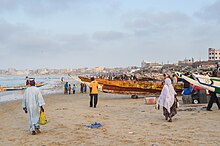
Senegal has a 12-nautical-mile (22 km; 14 mi) exclusive fishing zone that has been regularly breached in recent years (as of 2014[update]). It has been estimated that the country's fishermen lose 300,000 tonnes of fish each year to illegal fishing. The Senegalese government have tried to control the illegal fishing which is conducted by trawlers, some of which are registered in Russia, Mauritania, Belize and Ukraine. In January 2014 a Russian trawler, Oleg Naydenov, was seized by Senegalese authorities close to the maritime border with Guinea-Bissau.[35]
As a member of the West African Economic and Monetary Union (WAEMU), Senegal is working toward greater regional integration with a unified external tariff. Senegal is also a member of the Organization for the Harmonization of Business Law in Africa.[36]
Senegal realized full Internet connectivity in 1996, creating a mini-boom in information technology-based services. Private activity now accounts for 82 percent of its GDP.[citation needed] On the negative side, Senegal faces deep-seated[citation needed] urban problems of chronic high unemployment, socioeconomic disparity, and juvenile delinquency.[citation needed]
Senegal is a major recipient of international development assistance. Donors include the United States Agency for International Development (USAID), Japan, France and China. Over 3000 Peace Corps Volunteers have served in Senegal since 1963.[37]
Demographics

Senegal has a population of over 13.5 million,[38] about 42 percent of whom live in rural areas. Density in these areas varies from about 77 inhabitants per square kilometre (200/sq mi) in the west-central region to 2 per square kilometre (5.2/sq mi) in the arid eastern section.
Ethnic groups
Senegal has a wide variety of ethnic groups and, as in most West African countries, several languages are widely spoken. The Wolof are the largest single ethnic group in Senegal at 43 percent; the Fula[39] and Toucouleur (also known as Halpulaar'en, literally "Pulaar-speakers") (24%) are the second biggest group, followed by the Serer (14.7%),[40] then others such as Jola (4%), Mandinka (3%), Maures or (Naarkajors), Soninke, Bassari and many smaller communities (9%). (See also the Bedick ethnic group.)
About 50,000 Europeans (mostly French) and Lebanese[41] as well as smaller numbers of Mauritanians and Moroccans[citation needed] reside in Senegal, mainly in the cities. The majority of Lebanese work in commerce.[42] Also located primarily in urban settings are small Vietnamese communities as well as a growing number of Chinese immigrant traders, each numbering perhaps a few hundred people.[43][44] There are also tens of thousands of Mauritanian refugees in Senegal, primarily in the country's north.[45]
According to the World Refugee Survey 2008, published by the U.S. Committee for Refugees and Immigrants, Senegal has a population of refugees and asylum seekers numbering approximately 23,800 in 2007. The majority of this population (20,200) is from Mauritania. Refugees live in N'dioum, Dodel, and small settlements along the Senegal River valley.[46]
Languages

French is the official language, used regularly by a minority of Senegalese educated in a system styled upon the colonial-era schools of French origin (Koranic schools are even more popular, but Arabic is not widely spoken outside of this context of recitation). Most people also speak their own ethnic language while, especially in Dakar, Wolof is the lingua franca.[citation needed] Pulaar is spoken by the Fulas and Toucouleur. The Serer language is widely spoken by both Serers and non-Serers (including president Sall, whose wife is Serer); so are the Cangin languages, whose speakers are ethnically Serers. Jola languages are widely spoken in the Casamance.
Several of the Senegalese languages have the legal status of "national languages": Balanta-Ganja, Hassaniyya, Jola-Fonyi, Mandinka, Mandjak, Mankanya, Noon (Serer-Noon), Pulaar, Serer, Soninke, and Wolof.
Portuguese Creole, locally known as Portuguese, is a prominent minority language in Ziguinchor, regional capital of the Casamance, spoken by local Portuguese creoles and immigrants from Guinea-Bissau. The local Cape Verdean community speak a similar Portuguese creole, Cape Verdean Creole, and standard Portuguese. Portuguese was introduced in Senegal's secondary education in 1961 in Dakar by the country's first president, Léopold Sédar Senghor, it is currently available in most of Senegal and in higher education. It is especially prevalent in Casamance as it relates with the local cultural identity.[47]
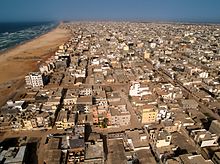
French, the only official language in the country, is facing a backlash as a consequence of a rising Senegalese linguistic nationalist movement, which supports the integration of Wolof, the common vernacular language of the country, into the national constitution.[48]
Largest cities
Senegal's capital of Dakar is by far the largest city in Senegal, with over two million residents.[49] The second most populous city is Touba, a de jure communaute rurale (rural community), with half a million.[49][50]
Template:Largest cities of Senegal
Religion
Religion in Senegal (2013)[51]
Senegal is a secular state.[31] Islam is the predominant religion in the country. Islam is practiced by approximately 94% of the country's population; the Christian community, at 5% of the population, are mostly Roman Catholics but there are still diverse Protestant denominations. One percent have animist beliefs, particularly in the southeastern region of the country.[2] Some Serer people follow the Serer religion.[52][53]
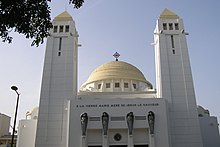
Majority of the Muslims in Senegal are Sunni with Sufi influences. Islamic communities in Senegal are generally organized around one of several Islamic Sufi orders or brotherhoods, headed by a khalif (xaliifa in Wolof, from Arabic khalīfa), who is usually a direct descendant of the group's founder. The two largest and most prominent Sufi orders in Senegal are the Tijaniyya, whose largest sub-groups are based in the cities of Tivaouane and Kaolack, and the Murīdiyya (Murid), based in the city of Touba. 27% are nondenominational Muslims.[54]
The Halpulaar (Pulaar-speakers), composed of Fula people, a widespread group found along the Sahel from Chad to Senegal, and Toucouleurs, represent 23.8 percent of the population.[2] Historically, they were the first to become Muslim. Many of the Toucouleurs, or sedentary Halpulaar of the Senegal River Valley in the north, converted to Islam around a millennium ago and later contributed to Islam's propagation throughout Senegal. Success was gained among the Wolofs, but repulsed by the Serers.
Most communities south of the Senegal River Valley, however, were not thoroughly Islamized. The Serer people stood out as one of this group, who spent over one thousand years resisting Islamization (see Serer history). Although many Serers are Christians or Muslim, their conversion to Islam in particular is very recent, who converted on their own free will rather than by force, although force had been tried centuries earlier unsuccessfully (see the Battle of Fandane-Thiouthioune).[55]
The spread of formal Quranic school (called daara in Wolof) during the colonial period increased largely through the effort of the Tidjâniyya. In Murid communities, which place more emphasis on the work ethic than on literary Quranic studies, the term daara often applies to work groups devoted to working for a religious leader. Other Islamic groups include the much older Qādiriyya order and the Senegalese Laayeen order, which is prominent among the coastal Lebu. Today, most Senegalese children study at daaras for several years, memorizing as much of the Qur'an as they can. Some of them continue their religious studies at councils (majlis) or at the growing number of private Arabic schools and publicly funded Franco-Arabic schools. A modern messianic sect in Islam, the Ahmadiyya Muslim Community is also present in the country which represents approximately 1% of the Muslim population.[56]
Small Roman Catholic communities are mainly found in coastal Serer, Jola, Mankanya and Balant populations, and in eastern Senegal among the Bassari and Coniagui. The Protestant churches are mainly attended by immigrants but during the second half of the 20th century Protestant churches led by Senegalese leaders from different ethnic groups have evolved. In Dakar Catholic and Protestant rites are practiced by the Lebanese, Cape Verdean, European, and American immigrant populations, and among certain Africans of other countries as well as by the Senegalese themselves. Although Islam is Senegal's majority religion, Senegal's first president, Léopold Sédar Senghor, was a Catholic Serer.

Serer religion encompasses a belief in a supreme deity called Roog (Koox among the Cangin), Serer cosmogony, cosmology and divination ceremonies such as the annual Xoy (or Khoye) ceremony precided over by the Serer Saltigues (high priests and priestesses). Senegambian (both Senegal and the Gambia) Muslim festivals such as Tobaski, Gamo, Koriteh, Weri Kor, etc., are all borrowed words from the Serer religion.[57] They were ancient Serer festivals rooted in Serer religion, not Islam.[57]
The Boukout is one of the Jola's religious ceremonies.
There are small numbers of adherents of Judaism and Buddhism. Judaism is followed by members of several ethnic groups, [who?] while Buddhism is followed by a number of Vietnamese. [citation needed] The Bahá'í Faith in Senegal was established after 'Abdu'l-Bahá, the son of the founder of the religion, mentioned Africa as a place that should be more broadly visited by Bahá'ís.[58] The first Bahá'is to set foot in the territory of French West Africa that would become Senegal arrived in 1953.[59] The first Bahá'í Local Spiritual Assembly of Senegal was elected in 1966 in Dakar.[60] In 1975 the Bahá'í community elected the first National Spiritual Assembly of Senegal. The most recent estimate, by the Association of Religion Data Archives in a 2005 report details the population of Senegalese Bahá'ís at 22,000.[61]
Health
Life expectancy by birth is estimated to 57.5 years.[38] Public expenditure on health was at 2.4 percent of the GDP in 2004, whereas private expenditure was at 3.5 percent.[62] Health expenditure was at US$72 (PPP) per capita in 2004.[62] The fertility rate ranged 5 to 5.3 between 2005 and 2013, with 4.1 in urban areas and 6.3 in rural areas, as official survey (6.4 in 1986 and 5.7 in 1997) point out.[63] There were 6 physicians per 100,000 persons in the early 2000s (decade).[62] Infant mortality was at 77 per 1,000 live births in 2005,[62] but in 2013 this figure had dropped to 47 within the first 12 months after birth.[38] In the past 5 years infant mortality rates of malaria have dropped. According to a 2013 UNICEF report,[64] 26% of women in Senegal have undergone female genital mutilation.
Education

Articles 21 and 22 of the Constitution adopted in January 2001 guarantee access to education for all children.[65] Education is compulsory and free up to the age of 16.[65] The Ministry of Labor has indicated that the public school system is unable to cope with the number of children that must enroll each year.[65]
Illiteracy is high, particularly among women.[62] The net primary enrollment rate was 69 percent in 2005. Public expenditure on education was 5.4 percent of the 2002–2005 GDP.
Culture
Senegal is well known for the West African tradition of storytelling, which is done by griots, who have kept West African history alive for thousands of years through words and music. The griot profession is passed down generation to generation and requires years of training and apprenticeship in genealogy, history and music. Griots give voice to generations of West African society.[17]
The African Renaissance Monument built in 2010 in Dakar is the tallest statue in Africa.
Cuisine
Because Senegal borders the Atlantic Ocean, fish is very important. Chicken, lamb, peas, eggs, and beef are also used in Senegalese cooking, but not pork, due to the nation’s largely Muslim population. Peanuts, the primary crop of Senegal, as well as couscous, white rice, sweet potatoes, lentils, black-eyed peas and various vegetables, are also incorporated into many recipes. Meats and vegetables are typically stewed or marinated in herbs and spices, and then poured over rice or couscous, or eaten with bread.
Popular fresh juices are made from bissap, ginger, buy (pronounced 'buoy', which is the fruit of the baobab tree, also known as "monkey bread fruit"), mango, or other fruit or wild trees (most famously soursop, which is called corossol in French). Desserts are very rich and sweet, combining native ingredients with the extravagance and style characteristic of the French impact on Senegal’s culinary methods. They are often served with fresh fruit and are traditionally followed by coffee or tea.
Music

Senegal is known across Africa for its musical heritage, due to the popularity of mbalax, which originated from the Serer percussive tradition especially the Njuup, it has been popularized by Youssou N'Dour and others. Sabar drumming is especially popular. The sabar is mostly used in special celebrations like weddings. Another instrument, the tama, is used in more ethnic groups. Other popular international renown Senegalese musicians are Ismael Lô, Cheikh Lô, Orchestra Baobab, Baaba Maal, Akon Thione Seck, Viviane, Titi and Pape Diouf.
Hospitality
Hospitality, in theory, is given such importance in Senegalese culture that it is widely considered to be part of the national identity. The Wolof[66] word for hospitality is "teranga" and it is so identified with the pride of Senegal that the national football team is known as the Lions of Teranga.[17][original research?]
Sports
Wrestling
Wrestling is Senegal's most popular sport[67] and has become a national obsession.[68] It traditionally serves many young men to escape poverty and it is the only sport recognized as developed independently of Western culture.
Football

Football is a popular sport in Senegal. In 2002, the team finished as runners-up at the Africa Cup of Nations and became one of only three African teams to ever reach the quarter-finals of the FIFA World Cup, defeating holders France in their first game. Popular players of this team included El-Hadji Diouf, Papa Bouba Diop, Khalilou Fadiga and Henri Camara, all of whom played in Europe.
Basketball
Basketball is also a popular sport in Senegal. The country has traditionally been one of Africa's dominant basketball powers. The men's team performed better than any other African nation at the 2014 FIBA World Cup, where they reached the playoffs for the first time. The women's team won 19 medals at 20 African Championships, more than twice as many medals as any competitor.
Motorsport
The country hosted the Paris–Dakar rally from 1979 until 2007.
See also
- Outline of Senegal
- Index of Senegal-related articles
- Agriculture in Senegal
- Telecommunications in Senegal
- Transport in Senegal
- Water supply and sanitation in Senegal
References
- ^ "La langue officielle de la République du Sénégal est le Français. Les langues nationales sont le Diola, le Malinké, le Pulaar, le Sérère, le Soninké, le Wolof et toute autre langue nationale qui sera codifiée." Official website of the Senegalese government
- ^ a b c d e f Central Intelligence Agency (2009). "Senegal". The World Factbook. Retrieved 12 October 2015.
- ^ a b c d "Senegal". International Monetary Fund. Retrieved 17 April 2013.
- ^ "Gini Index". World Bank. Retrieved 2 March 2011.
- ^ "2014 Human Development Report Summary" (PDF). United Nations Development Programme. 2014. pp. 21–25. Retrieved 27 July 2014.
- ^ "Definition of Senegal". The Free Dictionary. Retrieved 6 November 2013.
- ^ "Define Senegal". Dictionary.com. Retrieved 6 November 2013.
- ^ Janet H. Gritzner, Charles F. Gritzner – 2009, Senegal – Page 8
- ^ Ndiaye, Mbalo. "Senegal agricultural situation country report". U.S. Foreign Agricultural Service (January 17, 2007).
 This article incorporates text from this source, which is in the public domain.
This article incorporates text from this source, which is in the public domain.
- ^ Klein, Martin A., Islam and Imperialism in Senegal: Sine-Saloum, 1847–1914, p. 7, Edinburgh University Press (1968) ISBN 0-8047-0621-2
- ^ Gravrand, Henry, La civilisation Sereer, Pangool, p. 13. Dakar, Nouvelles Editions Africaines (1990), ISBN 2-7236-1055-1
- ^ "Slavery", Encyclopædia Britannica's Guide to Black History Archived 2014-10-06 at the Wayback Machine
- ^ a b Charles, Eunice A. Precolonial Senegal: the Jolof Kingdom, 1800–1890. African Studies Center, Boston University, 1977. p. 3
- ^ Ham, Anthony. West Africa. Lonely Planet. 2009. p. 670. ISBN 1-74104-821-4
- ^ Research in African literatures, Volume 37. University of Texas at Austin, p. 8. African and Afro-American Studies and Research Center, University of Texas (at Austin) (2006)
- ^ Diop, Cheikh Anta & Modum, Egbuna P. Towards the African renaissance: essays in African culture & development, 1946–1960, p. 28. Karnak House (1996). ISBN 0-907015-85-9
- ^ a b c Eric S. Ross, Culture and Customs of Senegal, Greenwood Press, Westport, CT, 2008 ISBN 0-313-34036-6
- ^ ""Goree and the Atlantic Slave Trade", Philip Curtin, History Net, accessed 9 July 2008". H-net.org. Retrieved 20 June 2010.
- ^ Les Guides Bleus: Afrique de l'Ouest(1958 ed.), p. 123
- ^ "Senegal in 1848" by Bruce Vandervort.
- ^ Klein, Martin A. Islam and Imperialism in Senegal: Sine-Saloum, 1847–1914, Edinburgh University Press (1968). p. X ISBN 0-8047-0621-2
- ^ A Critical bibliography of French literature: in three parts. The Twentieth. Edited by David Clark Cabeen, Richard A. Brooks, Douglas W. Alden
- ^ "Uppsala Conflict Data Program: Senegal: Casamance, In-depth Developments since 2005","], Conflict Encyclopedia
- ^ http://www.freedomhouse.org/report/freedom-world/2014/senegal-0#.VEWVY_nF-So
- ^ "The Ibrahim Index » Mo Ibrahim Foundation". Moibrahimfoundation.org. Archived from the original on 29 December 2011. Retrieved 3 January 2012.
{{cite web}}: Unknown parameter|deadurl=ignored (|url-status=suggested) (help) - ^ "Macky Sall Senegal election win 'example for Africa' | Africa". World.myjoyonline.com. 26 August 2012. Retrieved 25 November 2012.
- ^ "SENEGAL VOTES TO DO AWAY WITH SENATE TO SAVE MONEY". Associated Press. Retrieved 20 September 2012.
- ^ Statoids page on Senegal (noting that three new regions were split off on 10 September 2008).
- ^ List of current local elected officials from Union des Associations d' Elus Locaux (UAEL) du Sénégal. See also the law creating current local government structures: Template:Fr icon Code des collectivités locales, Loi n° 96-06 du 22 mars 1996.
- ^ "Senegal to send 2,100 troops to join Saudi-led alliance". Reuters. 4 May 2015.
- ^ a b "Constitution of Senegal (Article 1)" (PDF). Retrieved 4 August 2015.
- ^ "Public Anti-Corruption Initiatives". Business Anti-Corruption Portal. Retrieved 27 March 2014.
- ^ "Dakar, Senegal Climate Information – ClimateTemp.info, Making Sense of Average Monthly Weather & Temperature Data with Detailed Climate Graphs That Portray Average Rainfall & Sunshine Hours". ClimaTemps.com. 22 July 2011. Retrieved 29 March 2012.
- ^ "Weather rainfall and temperature data". World Climate.
- ^ 'Russia says factory ship was seized on Greenpeace's orders; Trawler held by Senegal over alleged illegal fishing' by John Vidal The Guardian (UK newspaper) 10 January 2014 page 23
- ^ "OHADA.com: The business law portal in Africa". Retrieved 22 March 2009.
- ^ "Peace Corps Senegal". Pcsenegal.org. Retrieved 20 June 2010.
- ^ a b c Template:Fr icon ANSD Retrieved 2013-12-10.
- ^ Template:Lang-fr; Template:Lang-ff
- ^ Gambia. CIA. The World Factbook
- ^ Senegal (03/08), U. S. Department of State
- ^ com/english/news/a-13-2007-07-10-voa46.html Lebanese Immigrants Boost West African Commerce, By Naomi Schwarz, voanews.com, 10 July 2007
- ^ Phuong, Tran (9 July 2007). "Vietnamese Continue Traditions in Senegal". Voice of America. Archived from the original on 19 February 2008. Retrieved 27 August 2008.
{{cite news}}: Unknown parameter|deadurl=ignored (|url-status=suggested) (help) - ^ Fitzsimmons, Caitlin (17 January 2008). "A troubled frontier: Chinese migrants in Senegal" (PDF). South China Morning Post. Retrieved 31 March 2009.
- ^ "Boost for the reintegration of Mauritanian returnees". UNHCR News. 26 November 2008. Retrieved 12 January 2010.
- ^ "World Refugee Survey 2008". U.S. Committee for Refugees and Immigrants. 19 June 2008. Archived from the original on 28 May 2010.
{{cite news}}: Unknown parameter|deadurl=ignored (|url-status=suggested) (help) - ^ José Horta (12–25 April 2006). "A Língua Portuguesa no Senegal". Instituto Camões. Retrieved 10 December 2014.
- ^ Pierre Cherruau (19 August 2012). "Le Sénégal est-il encore un pays francophone?". Retrieved 19 August 2012.
- ^ a b Agence Nationale de la Statistique et de la Démographie (2005). "Situation économique et sociale du Sénégal" (PDF) (in French). Government of Senegal. Archived from the original (PDF) on 25 June 2008. Retrieved 18 November 2008.
- ^ Forsberg, Jan. "Cities in Senegal". Retrieved 18 November 2008.
- ^ https://www.cia.gov/library/publications/the-world-factbook/geos/sg.html
- ^ Conklin, Alice L. "A mission to civilize: the republican idea of empire in France and West Africa, 1895–1930." Stanford University Press, 1997. ISBN 0-8047-2999-9 p. 27.
- ^ Lewis, M. Paul (ed.), 2009. Ethnologue: Languages of the World, Sixteenth edition. Dallas, Tex.: SIL International
- ^ http://www.pewforum.org/2012/08/09/the-worlds-muslims-unity-and-diversity-1-religious-affiliation/#identity
- ^ Hans Bressers; Walter A. Rosenbaum (2003). Achieving Sustainable Development: The Challenge of Governance Across Social Scales. Greenwood Publishing Group. pp. 151–. ISBN 978-0-275-97802-0.
- ^ "The World's Muslims: Unity and Diversity" (PDF). Pew Forum on Religious & Public life. 9 August 2012. Retrieved 7 April 2014.
- ^ a b Diouf, Niokhobaye, « Chronique du royaume du Sine, suivie de Notes sur les traditions orales et les sources écrites concernant le royaume du Sine par Charles Becker et Victor Martin (1972)», . (1972). Bulletin de l'IFAN, tome 34, série B, no 4, 1972, pp. 706–7 (pp. 4–5), pp. 713–14 (pp. 9–10)
- ^ 'Abdu'l-Bahá (1991) [1916–17]. Tablets of the Divine Plan (Paperback ed.). Wilmette, IL: Bahá'í Publishing Trust. pp. 47–59. ISBN 0-87743-233-3.
- ^ Hassall, Graham (c. 2000). "Egypt: Baha'i history". Asia Pacific Bahá'í Studies: Bahá'í Communities by country. Bahá'í Online Library. Retrieved 24 May 2009.
- ^ Bahá'í International Community (28 December 2003). "National communities celebrate together". Bahá'í International News Service.
- ^ "Most Baha'i Nations (2005)". QuickLists > Compare Nations > Religions >. The Association of Religion Data Archives. 2005. Retrieved 4 July 2009.
- ^ a b c d e "Human Development Report 2009 – Senegal". Hdrstats.undp.org. Retrieved 20 June 2010.
- ^ http://www.ansd.sn/publications/rapports_enquetes_etudes/enquetes/EDS-continue_2012-2013.pdf
- ^ UNICEF 2013, p. 27.
- ^ a b c "Senegal". 2005 Findings on the Worst Forms of Child Labor. Bureau of International Labor Affairs, U.S. Department of Labor (2006). This article incorporates text from this source, which is in the public domain. Archived 2014-01-09 at the Wayback Machine
- ^ The word taranga (hospitality), jom (honour), etc., are all Serer from the Serer language, rooted in Serer values and serer religion, not Wolof. See: Template:Fr icon Gravrand, Henry, "L'HERITAGE SPIRITUEL SEREER: VALEUR TRADITIONNELLE D'HIER, D'AUJOURD'HUI ET DE DEMAIN" [in] Ethiopiques, numéro 31, révue socialiste de culture négro-africaine, 3e trimestre 1982 [1]
- ^ "Sports in Africa: Communication and Media". Ohio University. Retrieved 3 April 2015.
- ^ "Wrestling As a Solution to Poverty in Senegal". PRI. Retrieved 3 April 2015.
Further reading
- Babou, Cheikh Anta, Fighting the Greater Jihad: Amadu Bamba and the Founding of the Muridiyya of Senegal, 1853–1913, (Ohio University Press, 2007)
- Behrman, Lucy C, Muslim Brotherhood and Politics in Senegal, (iUniverse.com, 1999)
- Buggenhage, Beth A, Muslim Families in Global Senegal: Money Takes Care of Shame, (Indiana University Press, 2012)
- Bugul, Ken, The Abandoned Baobab: The Autobiography of a Senegalese Woman, (University of Virginia Press, 2008)
- Foley, Ellen E, Your Pocket is What Cures You: The Politics of Health in Senegal, (Rutgers University Press, 2010)
- Gellar, Sheldon, Democracy in Senegal: Tocquevillian Analytics in Africa, (Palgrave Macmillan, 2005)
- Glover, John, Sufism and Jihad in Modern Senegal: The Murid Order, (University of Rochester Press, 2007)
- Kane, Katharina, Lonely Planet Guide: The Gambia and Senegal, (Lonely Planet Publications, 2009)
- Kueniza, Michelle, Education and Democracy in Senegal, (Palgrave Macmillan, 2011)
- Mbacké, Khadim, Sufism and Religious Brotherhoods in Senegal, (Markus Wiener Publishing Inc., 2005)
- Streissguth, Thomas, Senegal in Pictures, (Twentyfirst Century Books, 2009)
- Various, Insight Guide: Gambia and Senegal, (APA Publications Pte Ltd., 2009)
- Various, New Perspectives on Islam in Senegal: Conversion, Migration, Wealth, Power, and Femininity, (Palgrave Macmillan, 2009)
- Various, Senegal: Essays in Statecraft, (Codesria, 2003)
- Various, Street Children in Senegal, (GYAN France, 2006)
External links
- Country Profile from BBC News
- "Senegal". The World Factbook (2024 ed.). Central Intelligence Agency.
- Senegal Corruption Profile from the Business Anti-Corruption Portal
- Trade
- Ill-formatted IPAc-en transclusions
- Senegal
- Countries in Africa
- Member states of the African Union
- Economic Community of West African States
- G15 nations
- French-speaking countries and territories
- Least developed countries
- Member states of the Organisation internationale de la Francophonie
- Member states of the Organisation of Islamic Cooperation
- Republics
- States and territories established in 1960
- Member states of the United Nations
- West African countries
- Liberal democracies
- Muslim-majority countries





